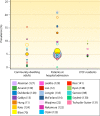Understanding Clostridium difficile Colonization
- PMID: 29540433
- PMCID: PMC5967689
- DOI: 10.1128/CMR.00021-17
Understanding Clostridium difficile Colonization
Abstract
Clostridium difficile is the main causative agent of antibiotic-associated and health care-associated infective diarrhea. Recently, there has been growing interest in alternative sources of C. difficile other than patients with Clostridium difficile infection (CDI) and the hospital environment. Notably, the role of C. difficile-colonized patients as a possible source of transmission has received attention. In this review, we present a comprehensive overview of the current understanding of C. difficile colonization. Findings from gut microbiota studies yield more insights into determinants that are important for acquiring or resisting colonization and progression to CDI. In discussions on the prevalence of C. difficile colonization among populations and its associated risk factors, colonized patients at hospital admission merit more attention, as findings from the literature have pointed to their role in both health care-associated transmission of C. difficile and a higher risk of progression to CDI once admitted. C. difficile colonization among patients at admission may have clinical implications, although further research is needed to identify if interventions are beneficial for preventing transmission or overcoming progression to CDI.
Keywords: Clostridium difficile; health care-associated infections; intestinal colonization.
Copyright © 2018 American Society for Microbiology.
Figures









Similar articles
-
Acquisition of Clostridium difficile Colonization and Infection After Transfer From a Veterans Affairs Hospital to an Affiliated Long-Term Care Facility.Infect Control Hosp Epidemiol. 2017 Sep;38(9):1070-1076. doi: 10.1017/ice.2017.140. Epub 2017 Jul 11. Infect Control Hosp Epidemiol. 2017. PMID: 28693636
-
Colonization versus carriage of Clostridium difficile.Infect Dis Clin North Am. 2015 Mar;29(1):13-28. doi: 10.1016/j.idc.2014.11.001. Epub 2015 Jan 13. Infect Dis Clin North Am. 2015. PMID: 25595843 Review.
-
Insight into alteration of gut microbiota in Clostridium difficile infection and asymptomatic C. difficile colonization.Anaerobe. 2015 Aug;34:1-7. doi: 10.1016/j.anaerobe.2015.03.008. Epub 2015 Mar 26. Anaerobe. 2015. PMID: 25817005
-
Bloom and bust: intestinal microbiota dynamics in response to hospital exposures and Clostridium difficile colonization or infection.Microbiome. 2016 Mar 14;4:12. doi: 10.1186/s40168-016-0156-3. Microbiome. 2016. PMID: 26975510 Free PMC article.
-
Asymptomatic Clostridium difficile colonization: epidemiology and clinical implications.BMC Infect Dis. 2015 Nov 14;15:516. doi: 10.1186/s12879-015-1258-4. BMC Infect Dis. 2015. PMID: 26573915 Free PMC article. Review.
Cited by
-
Faecal microbiota transplantation for Clostridioides difficile: mechanisms and pharmacology.Nat Rev Gastroenterol Hepatol. 2021 Jan;18(1):67-80. doi: 10.1038/s41575-020-0350-4. Epub 2020 Aug 25. Nat Rev Gastroenterol Hepatol. 2021. PMID: 32843743 Review.
-
Clostridium difficile infection following colon subtotal resection in a patient with gallstones: A case report and review of literature.World J Gastrointest Surg. 2024 Sep 27;16(9):3048-3056. doi: 10.4240/wjgs.v16.i9.3048. World J Gastrointest Surg. 2024. PMID: 39351567 Free PMC article.
-
Novel and emerging sources of Clostridioides difficile infection.PLoS Pathog. 2019 Dec 19;15(12):e1008125. doi: 10.1371/journal.ppat.1008125. eCollection 2019 Dec. PLoS Pathog. 2019. PMID: 31856240 Free PMC article. Review. No abstract available.
-
Faecal carriage of Clostridioides difficile is low among veterinary healthcare workers in the Netherlands.Epidemiol Infect. 2022 Feb 28;150:e63. doi: 10.1017/S0950268822000383. Epidemiol Infect. 2022. PMID: 35296372 Free PMC article.
-
Gut Microbiota and Colonization Resistance against Bacterial Enteric Infection.Microbiol Mol Biol Rev. 2019 Jun 5;83(3):e00007-19. doi: 10.1128/MMBR.00007-19. Print 2019 Aug 21. Microbiol Mol Biol Rev. 2019. PMID: 31167904 Free PMC article. Review.
References
-
- Walker AS, Eyre DW, Wyllie DH, Dingle KE, Harding RM, O'Connor L, Griffiths D, Vaughan A, Finney J, Wilcox MH, Crook DW, Peto TE. 2012. Characterisation of Clostridium difficile hospital ward-based transmission using extensive epidemiological data and molecular typing. PLoS Med 9:e1001172. doi:10.1371/journal.pmed.1001172. - DOI - PMC - PubMed
-
- Curry SR, Muto CA, Schlackman JL, Pasculle AW, Shutt KA, Marsh JW, Harrison LH. 2013. Use of multilocus variable number of tandem repeats analysis genotyping to determine the role of asymptomatic carriers in Clostridium difficile transmission. Clin Infect Dis 57:1094–1102. doi:10.1093/cid/cit475. - DOI - PMC - PubMed
-
- Eyre DW, Cule ML, Wilson DJ, Griffiths D, Vaughan A, O'Connor L, Ip CL, Golubchik T, Batty EM, Finney JM, Wyllie DH, Didelot X, Piazza P, Bowden R, Dingle KE, Harding RM, Crook DW, Wilcox MH, Peto TE, Walker AS. 2013. Diverse sources of C. difficile infection identified on whole-genome sequencing. N Engl J Med 369:1195–1205. doi:10.1056/NEJMoa1216064. - DOI - PMC - PubMed
-
- Debast SB, Bauer MP, Kuijper EJ, European Society of Clinical Microbiology and Infectious Diseases. 2014. European Society of Clinical Microbiology and Infectious Diseases: update of the treatment guidance document for Clostridium difficile infection. Clin Microbiol Infect 20(Suppl 2):S1–S26. doi:10.1111/1469-0691.12418. - DOI - PubMed
-
- Cohen SH, Gerding DN, Johnson S, Kelly CP, Loo VG, McDonald LC, Pepin J, Wilcox MH, Society for Healthcare Epidemiology of America, Infectious Diseases Society of America. 2010. Clinical practice guidelines for Clostridium difficile infection in adults: 2010 update by the Society for Healthcare Epidemiology of America (SHEA) and the Infectious Diseases Society of America (IDSA). Infect Control Hosp Epidemiol 31:431–455. doi:10.1086/651706. - DOI - PubMed
Publication types
MeSH terms
LinkOut - more resources
Full Text Sources
Other Literature Sources

